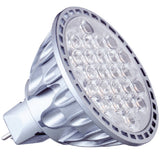Four Romantic Lighting Tips for Valentine's Day and Special Occasions
Posted by Nick on for ProLampSales

Years ago, I wrote an article on using light to set a romantic mood. That was in the days when red or pink incandescent light bulbs were still widely available, before the market had shifted to LED. And it was before LED prices had come down, making bulbs, strips, and new technology easily affordable by the average person. With Valentine's Day less than a month away, now is a good time to survey the latest technology for setting a romantic mood with lighting.
There are a number of factors that go into setting the right mood. These are color temperature, brightness, contrast, and focal points. While you can set a nice mood with just a handful of these elements, ignoring the others, taking all of them into account can have a drastic impact on the overall experience.
Color Temperature
Color temperature is what people usually think of when they consider whether lighting is "romantic" or not. Even if they don't know the term "color temperature," they can tell right away whether the lights are too bright or too white. We used to use red incandescent bulbs to make a warmer light, but now there are LED strips that can display red light and are much more flexible (literally).
While red-emitting LED strips may only be used on occasion for romantic lighting, warm dimming LED bulbs can be used in conventional settings throughout the day. Warm dimming LEDs can be dimmed from a higher to a lower color temperature, changing the quality of the light to feel warmer to the eye. This premium warm-dimming LED from Soraa, for instance, can be lowered from 2700K to 1800K.
Brightness
While color temperature plays a big role, and a too-high rating can make the light look too white or even blue, brightness can also kill a mood, even if the color temperature is right.
We've talked about warm dimming bulbs above, but dimmers can be used with any light to turn them down. Dimmer switches won't lower the color temperature of a bulb, but will make it so the bulb emits less light, letting more darkness fill the room.
Contrast
It's time for another technical lighting term, color rendering index. If the CRI of light is too low, colors can look washed out or blended together when they shouldn't be.
Years ago, high-CRI LED bulbs either didn't exist at all or were prohibitively expensive. However, now companies like Philips, Soraa, and Ushio make LED lights with a CRI of 95+, allowing for lower color temperatures, dimming capacity, and maintaining high quality colors.
This was a problem that didn't exist with incandescent and halogen bulbs, which have a CRI of 100, but CFL and LED bulbs often have CRIs much lower, in the 80s. The higher the CRI, the more contrast between colors can be perceived by human eyes.
The amount of light in a room and objects in it will also help or hurt contrast. Black objects don't reflect light as well as lighter objects, and lights with higher lumen counts will output more light than lower-lumen lamps or strips.
Focal Points
Finally, the lighting design portion of setting a romantic mood requires consideration of focal points. Objects in a room can be used to reflect various types or colors of light to create highlights. With other lights dimmed, these objects become the focal points of the room, so should be carefully chosen.
One way to control focal points is with bulbs with a particular beam angle. LED MR16s and LED PAR lamps come in a wide range of beam angles and can be used to highlight certain spots or flood particular areas with light, depending on the situation.
LED technology and the increasing affordability of LED lights have changed how easy (and safe) it is to set a romantic mood with lighting. Gone are the days of needing candles, a fireplace, or other potentially-dangerous light source to create low color temperatures. Consider using LED strips, warm dimming LED bulbs, dimmer switches, and high-CRI lights to set that perfect mood this Valentine's Day.
Featured Products (View All)
0 Comments




